Revision Notes: Anatomy of Flowering Plants | Biology Class 11 - NEET PDF Download
| Table of contents |

|
| Introduction to Plant Anatomy |

|
| The Tissue System |

|
| Anatomy of Dicotyledonous and Monocotyledonous Plants |

|
| Summary |

|
Introduction to Plant Anatomy
Anatomy is the study of the internal structure of plants. Plants exhibit similarities and differences in their internal structures, just like their external morphology. Cells, the basic units, organize into tissues, which form organs with distinct internal structures. In angiosperms, monocots and dicots show anatomical variations, reflecting adaptations to diverse environments.
The Tissue System
Tissues vary by structure and function depending on their location in the plant. Three main tissue systems are identified: epidermal, ground, and vascular.
1. Epidermal Tissue System
The epidermal tissue system is the outermost covering of the plant body, consisting of epidermal cells, stomata, and appendages like trichomes and hairs.
- Epidermis: Single-layered, made of compactly arranged parenchymatous cells with minimal cytoplasm and large vacuoles, covered by a waxy cuticle (absent in roots) to prevent water loss.
- Stomata: Present in leaf epidermis, regulate transpiration and gas exchange, composed of two guard cells (bean-shaped in dicots, dumb-bell shaped in grasses) enclosing a stomatal pore. Guard cells have chloroplasts and control opening/closing. Subsidiary cells surround guard cells, forming the stomatal apparatus.
- Epidermal Appendages: Root hairs (unicellular) aid in water and mineral absorption; trichomes (multicellular, branched/unbranched) on stems reduce water loss and may be secretory.
 Diagrammatic representation: (a) stomata with bean-shaped guard cells (b) stomata with dumb-bell shaped guard cell
Diagrammatic representation: (a) stomata with bean-shaped guard cells (b) stomata with dumb-bell shaped guard cell
2. Ground Tissue System
All tissues except epidermis and vascular bundles form the ground tissue, consisting of simple tissues like parenchyma, collenchyma, and sclerenchyma.
- Locations: Parenchyma in cortex, pericycle, pith, and medullary rays of primary stems and roots; mesophyll (chloroplast-containing parenchyma) in leaves.
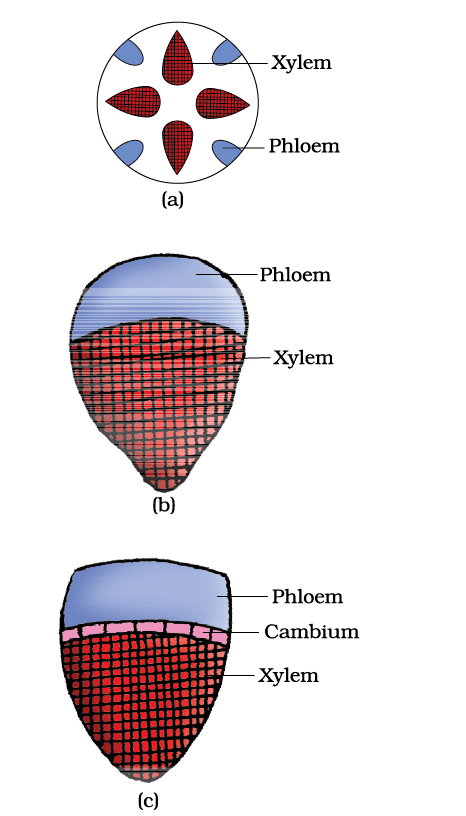 Various types of vascular bundles : (a) radial (b) conjoint closed (c) conjoint open
Various types of vascular bundles : (a) radial (b) conjoint closed (c) conjoint open
3. Vascular Tissue System
The vascular system comprises complex tissues: xylem and phloem, forming vascular bundles.
- Types of Vascular Bundles:
- Open: In dicot stems, cambium between xylem and phloem allows secondary growth.
- Closed: In monocots, no cambium, no secondary growth.
- Radial: Xylem and phloem alternate along different radii (e.g., roots).
- Conjoint: Xylem and phloem along the same radius, phloem typically outer to xylem (e.g., stems, leaves).
Anatomy of Dicotyledonous and Monocotyledonous Plants
Transverse sections of mature roots, stems, and leaves reveal tissue organization differences between dicots and monocots.
1. Dicotyledonous Root
Transverse section (e.g., sunflower root) shows:
- Epiblema: Outermost layer with unicellular root hairs.
- Cortex: Several layers of thin-walled parenchyma with intercellular spaces.
- Endodermis: Innermost cortex layer, single-layered, barrel-shaped cells with suberin casparian strips.
- Pericycle: Thick-walled parenchyma layers initiating lateral roots and vascular cambium.
- Vascular Bundles: 2-4 xylem and phloem patches, separated by conjunctive tissue, later forming a cambium ring.
- Pith: Small or inconspicuous.
- Stele: All tissues inside endodermis (pericycle, vascular bundles, pith).
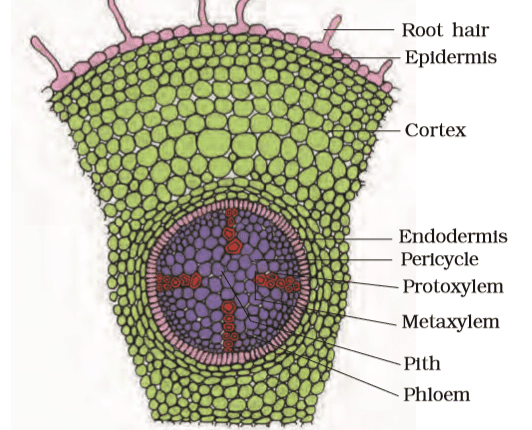 T.S. of root: dicot
T.S. of root: dicot
2. Monocotyledonous Root
Similar to dicot root but with distinct features:
- Polyarch vascular bundles: More than 6 xylem bundles.
- Large, well-developed pith.
- No secondary growth.
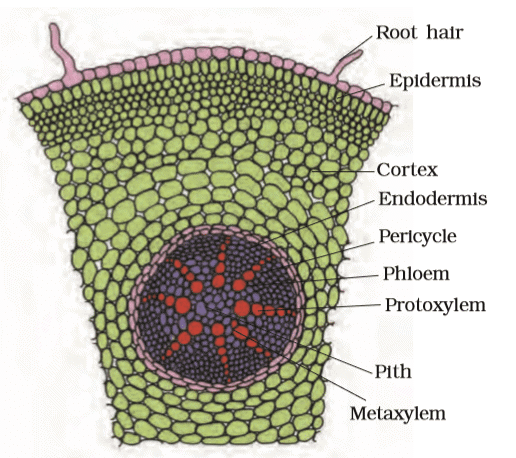 T.S. of Root: monocot
T.S. of Root: monocot
3. Dicotyledonous Stem
Transverse section of a young stem shows:
- Epidermis: Outermost layer with cuticle, trichomes, and stomata.
- Cortex: Three sub-zones:
- Hypodermis: Collenchyma layers for mechanical strength.
- Cortical layers: Parenchyma with intercellular spaces.
- Endodermis: Starch-rich layer (starch sheath).
- Pericycle: Sclerenchyma patches above phloem.
- Medullary Rays: Parenchyma between vascular bundles.
- Vascular Bundles: Arranged in a ring, conjoint, open, with endarch protoxylem.
- Pith: Large central parenchymatous region with intercellular spaces.
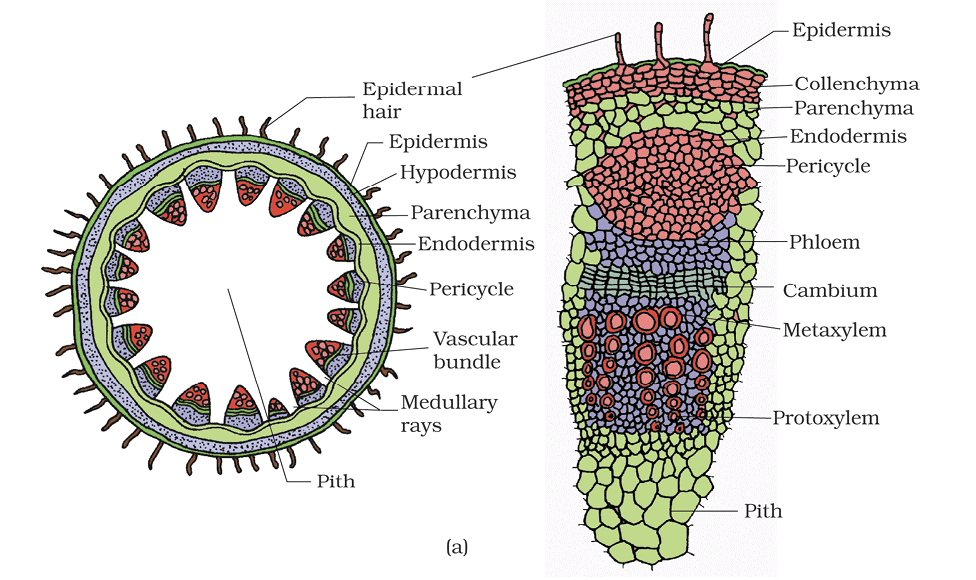 T.S. of stem: Dicot
T.S. of stem: Dicot
4. Monocotyledonous Stem
Transverse section shows:
- Hypodermis: Sclerenchymatous.
- Vascular Bundles: Scattered, conjoint, closed, surrounded by sclerenchymatous bundle sheath; peripheral bundles smaller than central ones.
- Ground Tissue: Large parenchymatous area, no phloem parenchyma, water-containing cavities in vascular bundles.
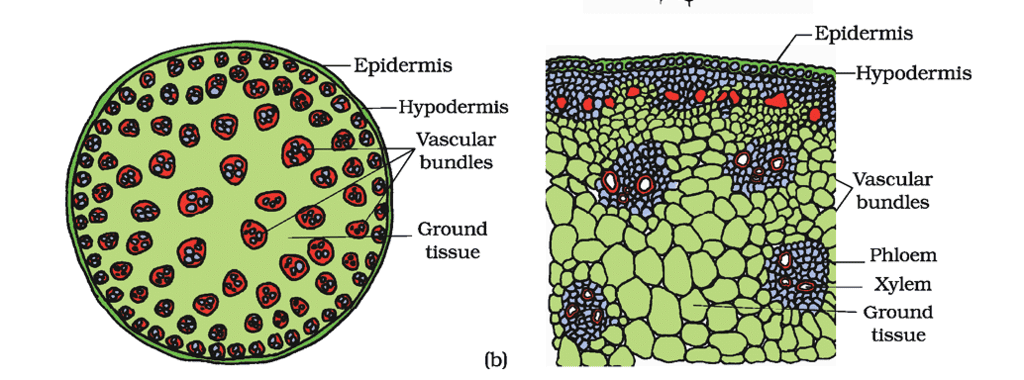 T.S. of stem: monocot
T.S. of stem: monocot
5. Dorsiventral (Dicotyledonous) Leaf
Vertical section through lamina shows:
- Epidermis: Adaxial (upper) and abaxial (lower) with cuticle; abaxial has more stomata.
- Mesophyll: Parenchyma with chloroplasts:
- Palisade parenchyma: Elongated, vertically arranged cells.
- Spongy parenchyma: Oval/round, loosely arranged with air cavities.
- Vascular System: Vascular bundles in veins/midrib, surrounded by thick-walled bundle sheath; size varies with vein thickness (reticulate venation).
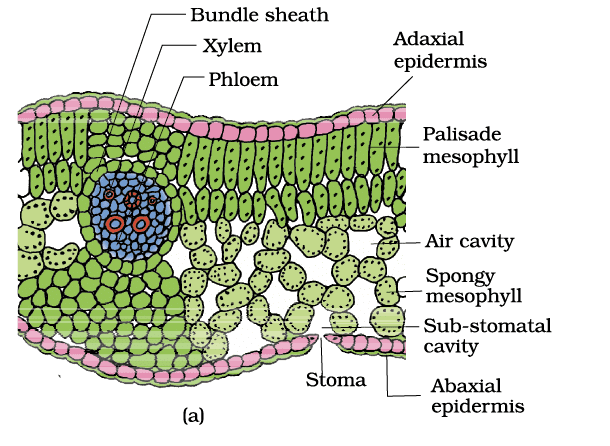
T.S. of Leaf: Dicot
6. Isobilateral (Monocotyledonous) Leaf
Similar to dorsiventral leaf but with differences:
- Stomata: Present on both epidermal surfaces.
- Mesophyll: Undifferentiated into palisade and spongy parenchyma.
- Bulliform Cells: Large, empty adaxial epidermal cells in grasses, curl leaves inward during water stress.
- Vascular Bundles: Near similar sizes due to parallel venation.
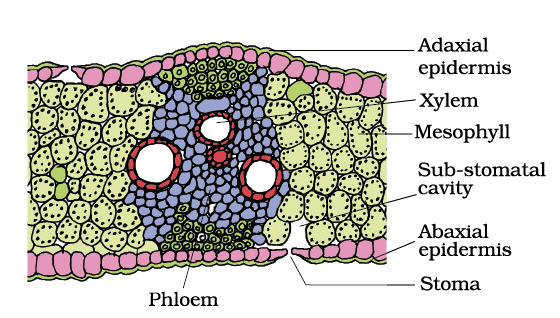 T.S. of leaf: Monocot
T.S. of leaf: Monocot
Summary
Plant anatomy involves tissues classified into meristematic and permanent types, organized into epidermal, ground, and vascular systems. Epidermal system includes epidermis, stomata, and appendages; ground system includes parenchyma, collenchyma, and sclerenchyma; vascular system includes xylem and phloem in bundles (open in dicots, closed in monocots). Dicots and monocots differ in root (polyarch vs. few bundles), stem (ring vs. scattered bundles), and leaf (dorsiventral vs. isobilateral) anatomy, with dicots showing secondary growth.
|
150 videos|399 docs|136 tests
|
FAQs on Revision Notes: Anatomy of Flowering Plants - Biology Class 11 - NEET
| 1. What are the main tissue types found in flowering plants? |  |
| 2. How do meristematic tissues contribute to plant growth? |  |
| 3. What role do xylem and phloem play in flowering plants? |  |
| 4. What is the significance of the root system in flowering plants? |  |
| 5. How do flowering plants adapt to their environment through anatomical features? |  |















